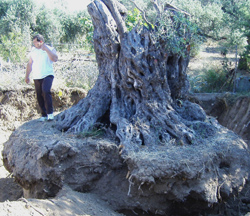You are here » Home » Telling Our Story
Success Story
Volunteers encourage others to value island’s ancient olive trees
Saving the Symbol of Peace

Photo: USAID/Cyprus
With a grant from USAID, the Olive Tree Project has saved over 350 olive trees, including this tree, which is estimated to be over 700 years old.
In the northern part of Cyprus alone, it is estimated that one tree is destroyed every hour to make way for roads, buildings and swimming pools.
Since antiquity, the olive tree has been both a symbol of peace and a source of prosperity. Today, Cyprus’ historic olive tree—a critical element of the island’s unique and picturesque landscape—is under threat from human development. In the island’s northern part alone, it is estimated that one tree is destroyed every hour to make way for roads, buildings and swimming pools. Over 10,000 trees were lost forever in 2005.
A small but dedicated group of volunteers known as the Olive Tree Project works to save Cyprus’ olive trees by raising public awareness and by arranging to move trees out of the path of destruction. This not-for-profit, private-sector initiative identifies olive trees in peril and arranges to have the trees moved into gardens or public spaces where they will be properly cared for. With a grant from USAID, the Olive Tree Project has moved over 350 olive trees in twenty months of operation, with the average age of the trees being 150 years. The oldest was estimated to be over 700 years old—a living witness to Cyprus long, culturally diverse but tumultuous past.
Moving trees is necessary but not enough to protect Cyprus’ olive trees from destruction and even potential extinction. So, the Olive Tree Project also works to persuade builders to plan around historic trees rather than remove them through a “friends of the olive tree” compact; provides the public with a 24/7 hotline to use to report trees at risk; and inspires educators and non-governmental organizations to make the olive tree’s cause part of larger efforts to preserve Cyprus’ environment.
Besides saving individual trees, the Olive Tree Project and USAID have contributed to protecting a unique part of Cyprus’ cultural heritage. The efforts to preserve this historic symbol of peace and goodwill are a fitting metaphor for USAID funding in Cyprus, which aims to facilitate the island’s reunification and the reconciliation between Greek Cypriots and Turkish Cypriots.
Print-friendly version of this page (533kb - PDF)
Click here for high-res photo
Back to Top ^ | 

